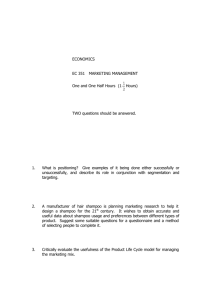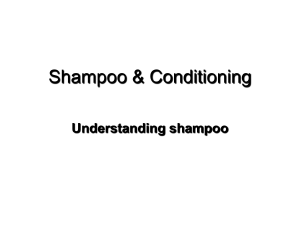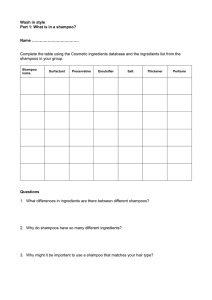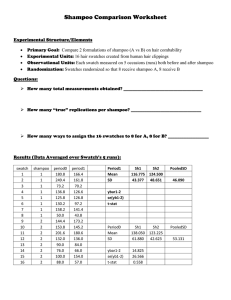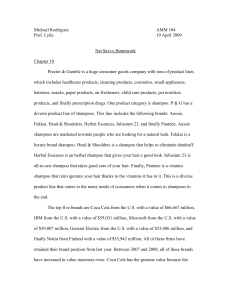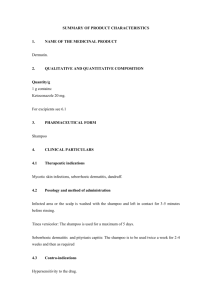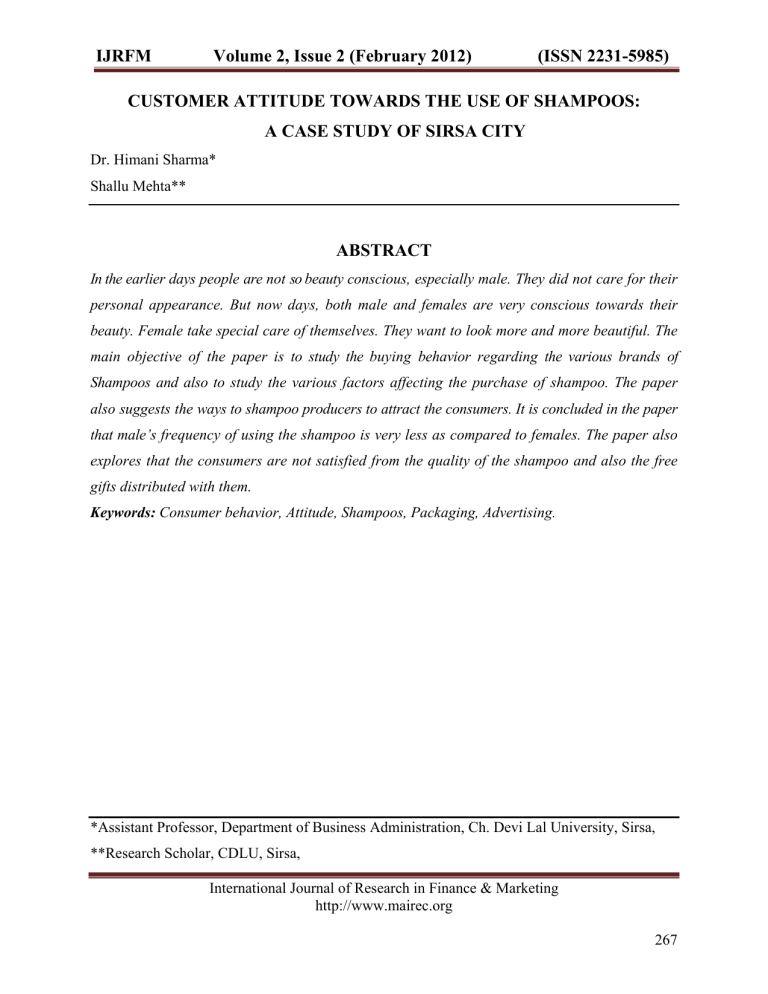
IJRFM Volume 2, Issue 2 (February 2012) (ISSN 2231-5985) CUSTOMER ATTITUDE TOWARDS THE USE OF SHAMPOOS: A CASE STUDY OF SIRSA CITY Dr. Himani Sharma* Shallu Mehta** ABSTRACT In the earlier days people are not so beauty conscious, especially male. They did not care for their personal appearance. But now days, both male and females are very conscious towards their beauty. Female take special care of themselves. They want to look more and more beautiful. The main objective of the paper is to study the buying behavior regarding the various brands of Shampoos and also to study the various factors affecting the purchase of shampoo. The paper also suggests the ways to shampoo producers to attract the consumers. It is concluded in the paper that male’s frequency of using the shampoo is very less as compared to females. The paper also explores that the consumers are not satisfied from the quality of the shampoo and also the free gifts distributed with them. Keywords: Consumer behavior, Attitude, Shampoos, Packaging, Advertising. *Assistant Professor, Department of Business Administration, Ch. Devi Lal University, Sirsa, **Research Scholar, CDLU, Sirsa, International Journal of Research in Finance & Marketing http://www.mairec.org 267 IJRFM Volume 2, Issue 2 (February 2012) (ISSN 2231-5985) FMCG SECTOR FMCG stands for Fast Moving Consumer Goods or also known as Consumer Packaged Goods. Fast Moving Consumer Goods (FMCG), are the products that are sold quickly at relatively low cost. These goods (FMCG) are those consumables which are normally consumed by the consumers at a regular interval. They are sold in large numbers, thus the profit behind these products is also high. These products are generally replaced or fully used up over a short period, usually a few days or weeks, or months, but within one year. Some common FMCG product categories include Detergents, Toilet soaps, Toothpaste, Hair care products, Creams, Powders, Food products, Confectioneries, Beverages etc. HAIR CARE MARKET IN INDIA Hair is aesthetically a very important part of the human body. All of us desire to have smooth, soft and lustrous hair. In Indian Market, various products are available for care of hair. These products include: Hair colorants & conditioners Hair oils Shampoos Hair gels SHAMPOO MARKET IN INDIA The word Shampoo is derived from the Hindi word “Champi”. Shampoo is a suitable detergent for washing hair, removing sweat, dirt and dead cells. The shampoo market in India has changed significantly since the 1960s when it first became a lifestyle product in urban homes. As of 2008, it was a very competitive market with dominant players such as Hindustan Unilever Ltd. and Procter & Gamble Company. TYPES OF SHAMPOOS There are many types of shampoos which are available in the market. These are of: Normal hair shampoos: They achieve good cleansing with minimum conditioning. Oily hair shampoos: They give excellent cleansing and very minimal conditioning. Dry hair shampoos: They cause mild cleansing and good conditioning. They reduce static electricity and make the hair more manageable. International Journal of Research in Finance & Marketing http://www.mairec.org 268 IJRFM Volume 2, Issue 2 (February 2012) (ISSN 2231-5985) Damaged hair shampoos: Meant for hair which have been chemically treated with hair color, bleaching agents or hair straightening agents. They have mild detergents and more conditioner in order to temporarily repair the hair surface defects. Baby Shampoos-These shampoos are produced with the feature of little or no irritation. Medicated Shampoos These shampoos includes Anti-dandruff shampoos, Anti-Lice shampoos. Conditioning Shampoos They are a combination of shampoo and conditioner. These products may be self-defeating since the shampoo removes sebum, the body's natural conditioner and replaces it with an artificial conditioner. OBJECTIVES OF THE STUDY: The main objectives of the study are: To study the buying behavior regarding the various brands of Shampoos and also to study the various factors affecting the purchase of shampoo. To study the consumer attitude for packaging shampoos. To suggest ways to shampoo producers to attract the consumers. RESEARCH METHODOLOGY For the purpose of Study, the design is on the basis of convenience sampling. Different occupational categories such as Business Class, Service Class, Housewives and Students have taken to check the consumer attitude towards shampoos. The scope of the study limits to area of Sirsa as a whole and the size of sample is 100 respondents. A structured questionnaire is used as research instrument which includes the relevant questions to know the consumer attitude towards shampoos. For analyzing the responses of respondents, we use simple averages and for the purpose of analysis of data, geographical representation was used which includes pie charts, bar charts, column charts etc. RESULTS AND DISCUSSIONS The following table shows the various demographic variables of respondents included in the sample. International Journal of Research in Finance & Marketing http://www.mairec.org 269 IJRFM Volume 2, Issue 2 (February 2012) (ISSN 2231-5985) Table 1: Profile of the respondents Characteristics No. of respondents Sex Male 50 Female 50 Age Less than 15 Yrs 18 15 to 25 yrs 26 25 to 35 Yrs 32 More than 35 yrs 24 Occupational Status Business Person 21 Service Person 24 Housewife 27 Student 28 Table 1 depicts that the total number of respondents are 100 in which the researcher has taken 50 from male side and 50 from female side. According to Age wise these respondents are categorized into four parts in which the researcher has taken 18 respondents which are of less than 15 yrs, 26 are of between 15 to 25 yrs, 32 are of between 25 to 35 yrs, and 24 are of more than 35 yrs. The researcher also divided these respondents according to their occupation i.e. 21 are of business person, 24 are of service person, 27 are housewife and 28 students are involves as a respondents of the study. Table 2 Response regarding use of shampoo Response Male Female Total Yes 23 49 72 No 27 01 28 Total 50 50 100 International Journal of Research in Finance & Marketing http://www.mairec.org 270 IJRFM Volume 2, Issue 2 (February 2012) (ISSN 2231-5985) Table 2 shows the response regarding use of shampoo. Out of 50 male respondents only 23 use the shampoo, 27 do not use this product and also out of 50 females, 49 use shampoos whereas one cannot use it. Thus it is concluded that male’s frequency of using the shampoo is very less as compared to females. Table 3 Brand Preference in Shampoo Brand Male (%) Female (%) Total (%) Pantene Pro-v 4(5.56) 8(11.11) 12(16.67) Sunsilk 8(11.11) 12(16.67) 20(27.78) Clinic Plus 6(8.3) 7(9.72) 13(18.06) Organic 1(1.3) 4(5.56) 5(6.94) Ayur 0(0) 4(5.56) 4(5.56) Nyle 0(0) 2(2.78) 2(2.78) Vatika 0(0) 2(2.78) 2(2.78) Clinic All Clear 2(2.78) 6(8.33) 8(11.11) Head & Shoulders 2(2.78) 3(4.17) 5(6.94) 0(0) 1(1.39) 1(1.39) 23(31.94) 49(68.06) 72(100) Others Total Note: The figures in parenthesis shows the percentage values of respondents. International Journal of Research in Finance & Marketing http://www.mairec.org 271 IJRFM Volume 2, Issue 2 (February 2012) (ISSN 2231-5985) Table 3 shows the percentage of respondents for brand preference of shampoos. As the table shows Sunsilk Shampoo is more preferred by both male and females. Males do not use the shampoo like Nyle, Vatika, and Ayur etc. It means that they do not concentrate on herbal shampoos and also in female, Nyle and Vatika is less preferred as compare to Sunsilk, Pantene, Clinic All Clear etc. Thus it is concluded that the consumers do not concentrate on the natural shampoos, they use it only for the purpose of cleaning only, not for to make their hair healthier and stronger, or they do not know the value of using natural shampoos. Table 4 Frequency of use of Shampoo Frequency Male (%) Female (%) Total (%) Daily 7(9.72) 4(5.56) 11(15.28) Twice a week 2(2.78) 17(23.61) 19(26.39) Weekly 4(5.56) 18(25.00) 22(30.56) Monthly 2(2.78) 4(5.56) 6(8.33) Occasionally 8(11.11) 6(8.33) 14(19.44) Total 23(31.94) 49(68.06) 72(100) Note: The figures in parenthesis shows the percentage values of respondents. International Journal of Research in Finance & Marketing http://www.mairec.org 272 IJRFM Volume 2, Issue 2 (February 2012) (ISSN 2231-5985) Table 4 explores the frequency of shampoo. As per this table, 11.11% male use the shampoo occasionally and 9.72% use the shampoo daily. And in females, they use the shampoo mostly weekly (25%). Thus as per this data, it is concluded that the frequency of shampoo usage in males is very low. They use shampoo on special occasions such as weddings, parties etc. Table 5 Preference of packaging for shampoo Response No. of Respondents (%) Sachet 39(54.17) Bottles 33(45.83) Total 72(100) Note: The figures in parenthesis shows the percentage values of respondents. International Journal of Research in Finance & Marketing http://www.mairec.org 273 IJRFM Volume 2, Issue 2 (February 2012) (ISSN 2231-5985) Table 5 depicts the attitude regarding the preference of shampoo packaging. 54.17% likes the sachet for packing the shampoo, whereas 45.83% like the bottles for packing the same. Table 6 Media Preference for advertisements Media No. of Respondents TV Ads 37(51.39) Newspapers 17(23.61) Magazines 4(5.56) Pamphlets 8(11.11) Hoardings 4(5.56) Others 2(2.78) Total 72(100) Note: The figures in parenthesis shows the percentage values of respondents. International Journal of Research in Finance & Marketing http://www.mairec.org 274 IJRFM Volume 2, Issue 2 (February 2012) (ISSN 2231-5985) Table 6 shows the media preferences for advertisements. The maximum respondents i.e. 51.39% prefer the TV for see the advertisement. And hoardings and magazines are less preferred by them. Table 7 Factors affecting the purchase of present brand Factors Fully satisfied Satisfied Not Satisfied Total Price 12(16.67) 34(47.22) 26(36.11) 72(100) Quality 28(38.89) 14(19.44) 30(41.67) 72(100) Availability 41(59.64) 27(37.50) 4(5.56) 72(100) Packaging 32(44.44) 15(20.83) 25(34.72) 72(100) Free Gifts 11(15.28) 23(31.94) 38(52.78) 72(100) Advertising 26(36.11) 32(44.44) 14(19.44) 72(100) Note: The figures in parenthesis shows the percentage values of respondents. International Journal of Research in Finance & Marketing http://www.mairec.org 275 IJRFM Volume 2, Issue 2 (February 2012) (ISSN 2231-5985) Table 7 depicts the factors affecting the purchase of present brand. As per this table, the researcher has taken six major factors including price, quality, availability, packaging, free gifts, advertising etc. Then these factors are studied on the basis of 3-scale i.e. fully satisfied, satisfied and not satisfied. In case of price 47.22% persons are satisfied with the price of the present brand. In case of quality, near about 30% respondents are not satisfied from the quality. In case of availability of shampoos, 41% are fully satisfied, in case of Packaging of shampoos, near about 44% are satisfied from the packaging, whereas in case of free gifts near about 38% are not satisfied. And also 32% of the respondents are satisfied from the advertising of shampoos. CONCLUSION OF STUDY Male’s frequency of using the shampoo is very less as compared to females. The consumers do not concentrate on the natural shampoos, they use it only for the purpose of cleaning only, not for to make their hair healthier and stronger, or they do not know the value of using natural shampoos. The frequency of shampoo usage in males is very low. They use shampoo on special occasions such as weddings, parties etc. The maximum respondents i.e. 51.39% prefer the TV for see the advertisement. International Journal of Research in Finance & Marketing http://www.mairec.org 276 IJRFM Volume 2, Issue 2 (February 2012) (ISSN 2231-5985) The consumers are not satisfied from the quality of the shampoo and also the free gifts distributed with them. Sachet is more preferred as compared to bottles for the purpose of packaging of shampoo. RECOMMENDATIONS FOR SHAMPOO MARKETERS Target those people who are the non-users of shampoo or who use the shampoo on occasionally basis. The reason may be behind this that they cannot afford the shampoo. Therefore, the companies have to launch their shampoos in small sachet containing enough quantity for one wash. The marketers of shampoo have a need to increase awareness among all levels of consumer’s especially male consumers. The marketers have to design the shampoo not only on the basis of function or benefits of the product but by studying all the factors which affects their buying behavior including the competitive products, references of the consumers etc. The marketer has to concentrate more on the natural shampoos as they are formed through natural ingredients instead of synthesized chemicals. Thus in that way these natural shampoos help the hair by making it shiner, lighter and healthier. And also there is a need to communicate this message to the consumers. The marketers have also consider the problems of consumers like falling hair, dandruff, lice etc while developing the product and make it a medicated shampoo. While communicating their products, the shampoo marketers have to take extra care, and advertise all the possible advantages of using their shampoo. They have to use the phrases like remove dandruff in seconds, extra care for every type of hair etc. REFERENCES: 1. “Hair care product portfolios in a mature market” (2007). www.tutor2u.net 2. ACNielsen (2004), “Hair care practices of India’s most beautiful woman”. www.pg_India.com. 3. C.K. Ranganathan (2007) “How cavinkare competes with other shampoos companies in Indian Market” . www.cavinkare.com. 4. Global Report (2006), “Paradigm shift for India’s hair care”. www.gcimagazine.com. International Journal of Research in Finance & Marketing http://www.mairec.org 277 IJRFM Volume 2, Issue 2 (February 2012) (ISSN 2231-5985) 5. http://www.icmrindia.org/casestudies/catalogue/Marketing%20Mini%20Case%20Studies /CLMKTG004.htm 6. http://www.whereincity.com/medical/topic/skin-and-beauty/articles/381.htm International Journal of Research in Finance & Marketing http://www.mairec.org 278
